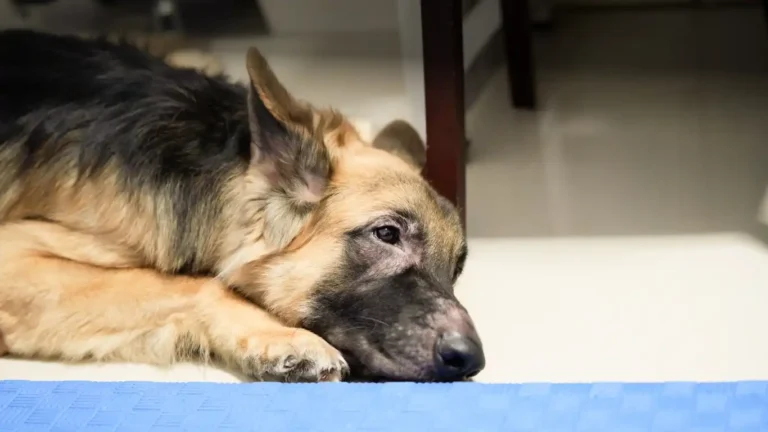Why is my dog’s belly turning dark? Discover the shocking causes and solutions
If you’ve ever found yourself wondering, “Why is my dog’s belly turning dark?”, you’re definitely not alone. As a Veterinary Assistant with a nutrition focus, I’ve seen this question come up quite often — and for good reason. Noticing changes in your pup’s skin color, especially on such a sensitive area as the belly, can be a bit unsettling. It’s one of those subtle signs that something might be going on beneath the surface, and as a caring pet parent, you want to get to the bottom of it quickly.
From my hands-on experience working closely with dogs and their owners, I can tell you that a darkening belly isn’t always cause for panic, but it is worth paying attention to. The skin on your dog’s belly can change color for a variety of reasons, ranging from simple environmental factors to more complex health issues. In this article, I’ll break down what might be causing this change, what you should look out for, and when it’s time to check in with your vet.
Understanding Why Your Dog’s Belly Might Be Darkening

First off, it’s important to recognize that a dog’s skin can naturally darken with age or due to pigmentation differences based on breed and coat color. But when the darkening is sudden or accompanied by other symptoms, that’s when it becomes more noticeable and potentially concerning.
Common Causes of Darkened Belly Skin
Here are some typical reasons why your dog’s belly skin might be turning darker:
- Friction and Pressure: Dogs who love lounging on hard surfaces or rubbing their bellies on rough ground might develop thicker, darker skin in those areas due to constant friction.
- Sun Exposure: Just like us, dogs’ skin can get tanned or sun-damaged over time, especially if they spend a lot of time outside without protection.
- Hormonal Changes: Hormonal imbalances, particularly those related to thyroid function or adrenal glands, can cause skin pigmentation changes.
- Allergic Reactions: Allergies—whether environmental, food-related, or contact allergies—can lead to inflammation and darkening of the skin.
- Infections or Parasites: Yeast infections and certain parasites can irritate the skin and cause discoloration.
In my time assisting veterinarians and guiding pet owners, I’ve noticed that friction and allergies tend to be the top culprits, but every dog is unique. Observing your dog’s habits and environment can offer clues.
Spotting Other Symptoms That Accompany a Darkening Belly
Skin darkening can sometimes be just a cosmetic issue, but often it comes with other signs that point to an underlying problem. Watch out for:
- Itching or Scratching: Persistent itching may indicate allergies or infections.
- Hair Loss: Patches of missing fur along with darkened skin suggest irritation or skin disease.
- Odor: A strong, unpleasant smell can be a sign of a yeast infection.
- Redness or Swelling: Inflammation often accompanies infections or allergic reactions.
- Behavioral Changes: If your dog seems uncomfortable or is licking the area excessively, it’s a red flag.
When I first encountered a dog with a suddenly dark belly, the owner mentioned the dog was licking the area constantly and seemed restless. That’s usually a sign that something more than just cosmetic is happening.
When to Worry About Your Dog’s Darkening Belly

Now, I get it—seeing your dog’s belly change color can be a little alarming. But here’s the deal: not every dark patch or change means serious trouble. From my experience in veterinary care, the key is to tune into what else is happening alongside the darkening. If it’s just a slow change over time without other symptoms, it might be harmless. But if your dog is showing signs of discomfort, or the skin looks irritated or thickened, it’s time to dig deeper.
Here are a few situations where you shouldn’t delay in getting professional advice:
- Rapid skin darkening—especially if it’s spreading.
- Severe itching or biting that keeps your dog restless.
- Open sores, scabs, or bleeding around the discolored area.
- Hair loss or patchiness accompanying the dark skin.
- Signs of pain or sensitivity when you touch the belly.
From what I’ve seen in clinics, when owners catch these signs early and bring their dog in, vets can often diagnose and treat the problem before it worsens. Delaying can lead to chronic skin issues that are tougher to manage.
How Nutrition Plays a Role in Your Dog’s Skin Health

Given my background with a nutrition focus, I can’t stress enough how important diet is when it comes to your dog’s skin—and by extension, why your dog’s belly might be turning dark. Skin is the largest organ and it reflects what’s going on inside your dog’s body. Poor nutrition or food sensitivities can weaken the skin barrier, making it prone to infections, irritation, and pigment changes.
Key Nutrients for Maintaining Healthy Skin
Feeding your dog a balanced diet rich in these nutrients can make a world of difference:
- Omega-3 and Omega-6 Fatty Acids: These healthy fats reduce inflammation and keep skin supple. You’ll find them in fish oils, flaxseed, and certain high-quality dog foods.
- Vitamins A and E: Crucial antioxidants that protect skin cells from damage and promote healing.
- Zinc and Biotin: Important minerals that support skin repair and hair growth.
- Protein: The building blocks of healthy skin and fur. Low-quality or insufficient protein can lead to dull coats and skin issues.
Once, I worked with a pup whose darkened belly was linked to a subtle food allergy. Switching to a hypoallergenic diet and adding omega-3 supplements helped clear up the skin dramatically over a few weeks. It’s amazing how food impacts your dog’s health beyond just energy and growth!
Common Skin Conditions That Cause Belly Darkening

Sometimes, darkened skin is a symptom of a deeper skin problem. Here are a few common conditions I’ve frequently encountered that could explain why your dog’s belly is turning dark:
1. Acanthosis Nigricans
This is a condition where the skin thickens and darkens, often affecting the belly and folds. It’s usually linked to hormonal imbalances or obesity. Dogs with this condition may have velvety, rough patches on their skin.
2. Yeast Infections
Yeast loves warm, moist areas—like your dog’s belly. Overgrowth can cause itching, odor, and darkening. If your dog is licking or scratching that area a lot, yeast might be the culprit.
3. Allergic Dermatitis
Allergies, whether to food, pollen, or flea bites, often cause redness, itching, and eventually dark pigmentation from chronic scratching and inflammation.
4. Hyperpigmentation from Chronic Inflammation
Any ongoing skin irritation—think repeated infections or irritants—can cause the skin to respond by producing more pigment, leading to darker patches.
When I assist vets during skin checks, we always examine the type of discoloration and feel of the skin closely. Sometimes, a simple skin scraping or biopsy is needed to nail down the cause and guide treatment.
Effective Ways to Care for and Prevent Darkening of Your Dog’s Belly

After working hands-on with dogs facing various skin challenges, I can tell you that prevention and proper care go a long way in managing a darkening belly. The good news? Many causes are manageable with simple lifestyle tweaks and consistent attention.
Daily Habits That Can Help Keep Your Dog’s Belly Skin Healthy
Here are some easy but effective things you can do at home to support your dog’s skin health and potentially prevent further darkening:
- Regular Baths with Gentle, Skin-Friendly Shampoos: Choose shampoos formulated for sensitive or allergy-prone skin. Avoid harsh chemicals that strip natural oils, which can worsen irritation.
- Keep the Belly Dry: Moisture buildup, especially after walks or playtime in wet grass, can promote yeast growth. Pat your dog’s belly dry gently but thoroughly.
- Balanced Nutrition: Stick to high-quality dog food that supports skin health, including omega fatty acids and essential vitamins. Supplement with vet-approved oils if needed.
- Minimize Allergens: If you know your dog reacts to certain plants, fabrics, or foods, try to avoid exposure. Regularly wash bedding and toys to reduce dust mites and other irritants.
- Routine Vet Checkups: Don’t skip those wellness visits—early detection of skin or hormonal problems is key to effective treatment.
From my experience, dogs whose owners are proactive with skin care tend to bounce back faster when issues arise. It’s like giving your dog a little daily TLC that pays off big time.
When Medical Treatment Is Needed
Sometimes, lifestyle changes aren’t enough, especially if the darkening is caused by infections, allergies, or hormonal disorders. In those cases, veterinarians may recommend:
- Medicated Shampoos: Formulated to treat yeast or bacterial infections specifically.
- Antihistamines or Steroids: To control severe itching and inflammation.
- Hormone Therapy: For underlying endocrine issues like hypothyroidism.
- Allergy Testing and Specialized Diets: To identify and eliminate triggers causing skin problems.
One thing I’ve learned is that following your vet’s advice closely and being patient with treatment is crucial. Skin problems can take time to heal fully, but with proper care, your dog’s belly can often return to a healthy color and texture.
Final Tips and What to Watch For Going Forward
Keep in mind that your dog’s skin is a window into their overall health. If you notice any sudden or drastic changes in color, texture, or behavior, it’s a good idea to take action sooner rather than later. I always encourage pet parents to be curious and observant—those little daily moments spent checking your dog’s skin can catch issues early.
Remember, every dog is different, and what works for one might not for another. Keep open communication with your vet, share any changes you observe, and don’t hesitate to ask questions. From my work in the clinic, I can say that a well-informed, attentive owner is one of the best allies a dog can have in staying healthy.
References
Disclaimer
This article is intended for informational purposes only and is not a substitute for professional veterinary advice, diagnosis, or treatment. If you notice any changes in your dog’s skin or health, please consult your veterinarian promptly. Individual cases may vary, and only a qualified vet can provide personalized care recommendations based on a thorough examination.






